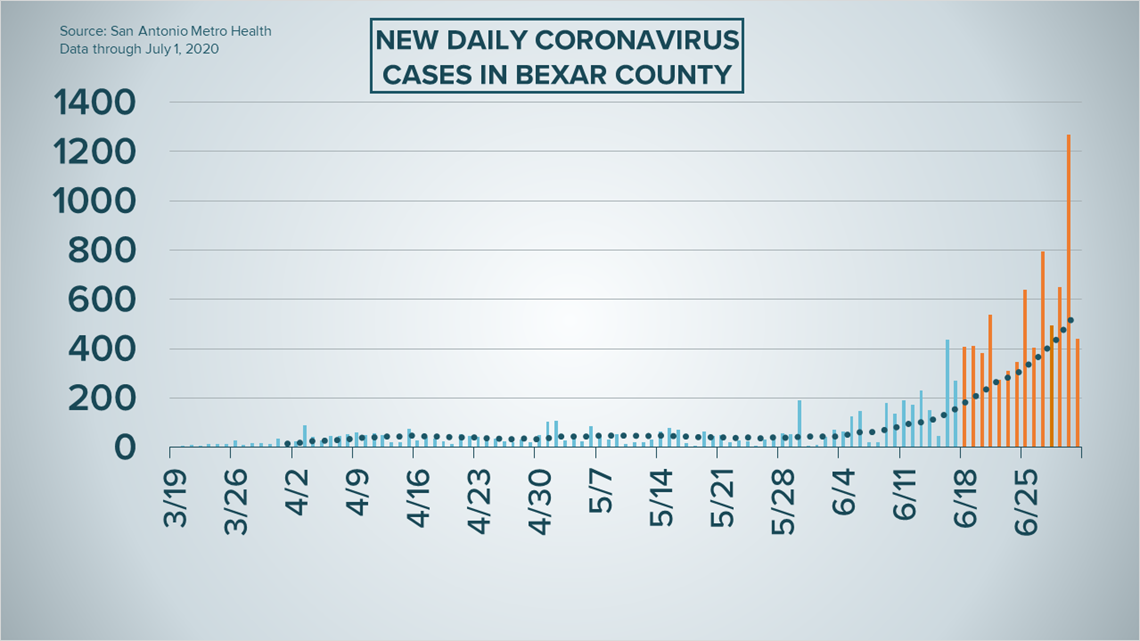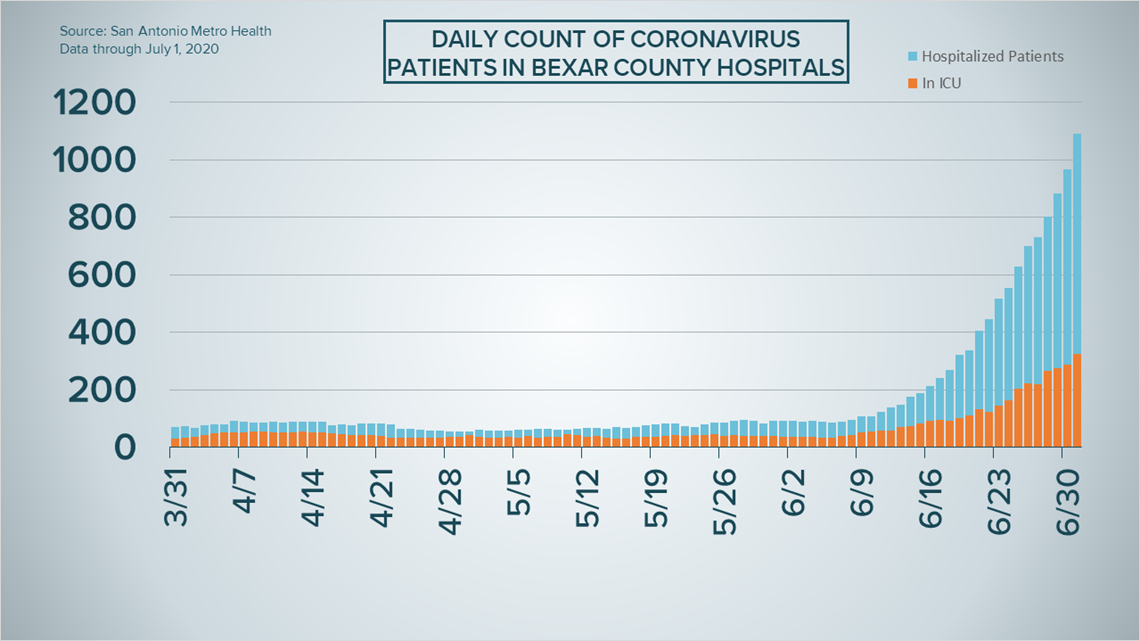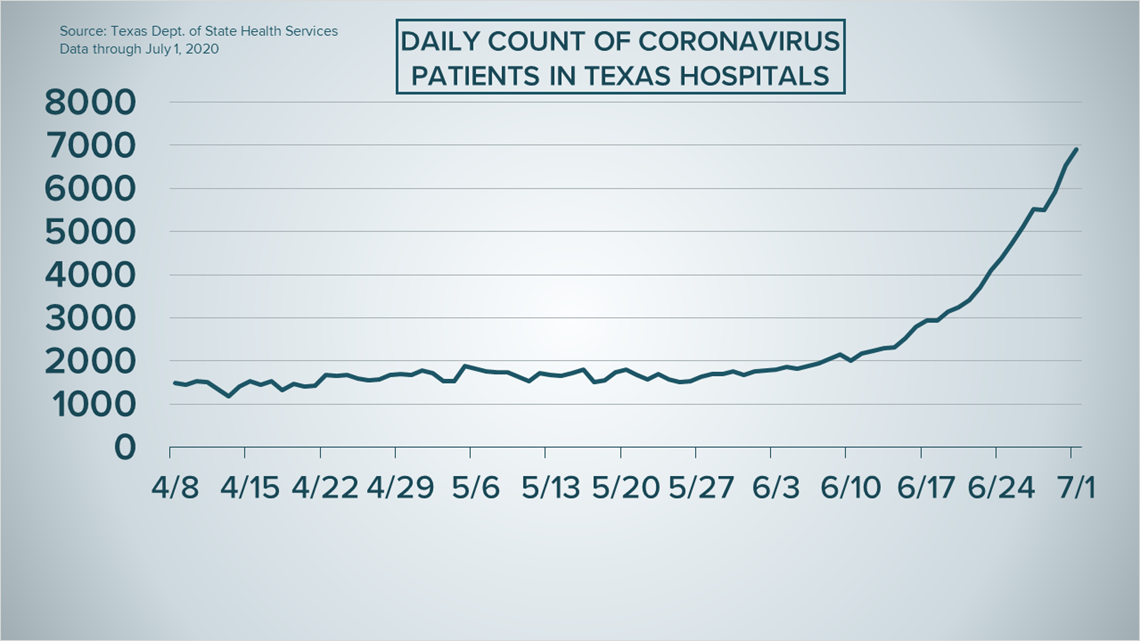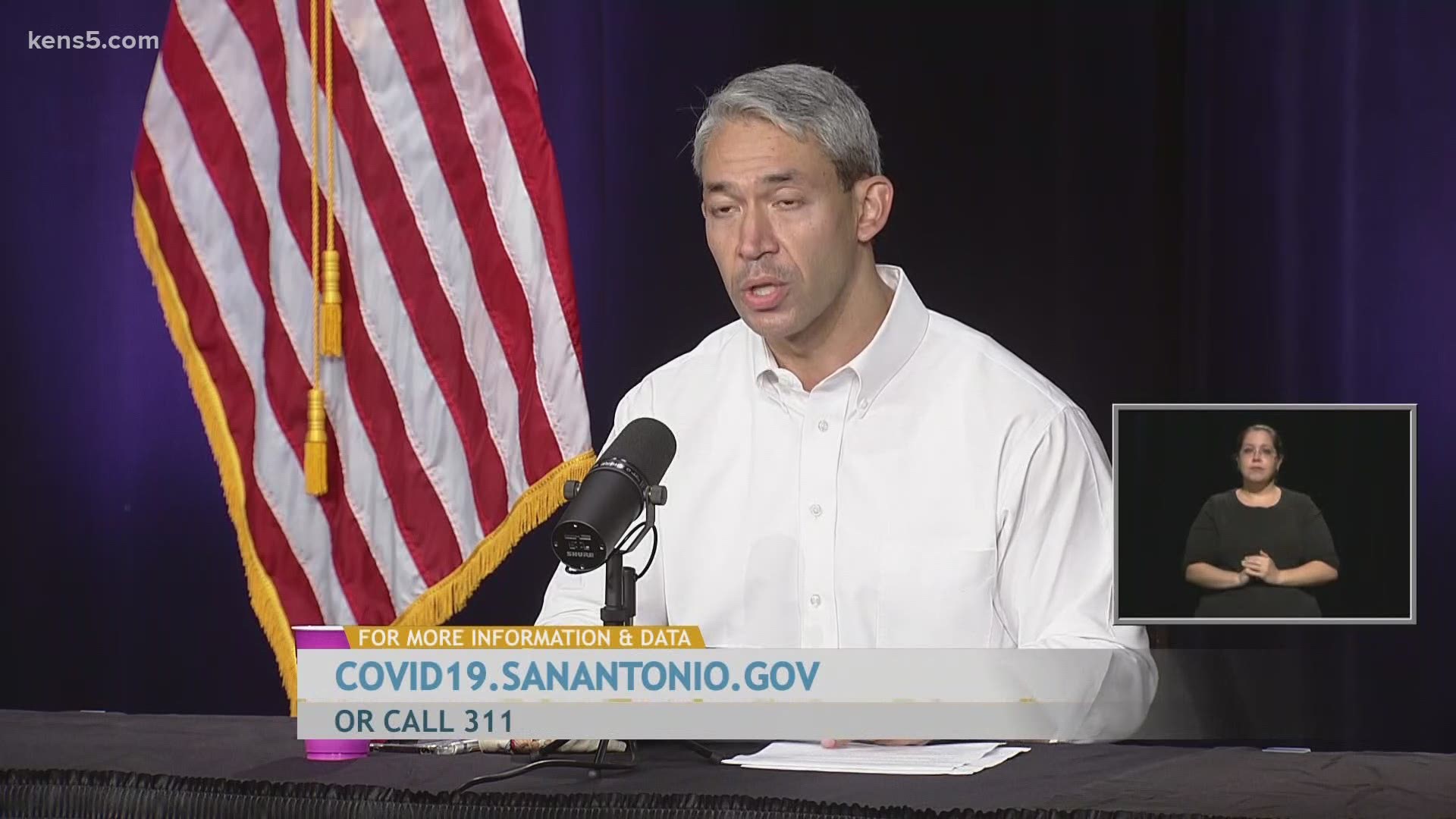SAN ANTONIO — We're tracking the latest numbers from the coronavirus pandemic in San Antonio and across Texas. Here are the latest numbers reported by Bexar and surrounding counties:
- Bexar County: 439 new cases were reported Wednesday, along with one additional virus-related death. There is a total of 12,504 cases and 111 fatalities in the county. The number of county residents currently in local hospitals surpassed 1,000 for the first time, with 1,019 total, and 324 of those are in the ICU.
- Comal County: The county reported 58 new coronavirus cases and one fatality Thursday. Eight people have now died in the county, while 275 have recovered. The positivity rate has risen to 12.63%, the highest the county has recorded since the pandemic began. As of Thursday, there is a total of 836 confirmed and probable coronavirus cases in Comal County.
- Hays County: 105 new cases were reported Wednesday, bringing the total to 2,924 cases and seven fatalities in the county. 83% of those cases are considered active, and 50% of the county's confirmed cases are people between the ages of 20 and 29.
Here are Wednesday's full numbers. Bexar County reports them daily at 7 p.m.:
How Bexar County is trending:
We're tracking how many coronavirus cases are confirmed in Bexar County each day from the time San Antonio Metro Health began reporting cases more than two months ago. Graphing those daily case numbers along a 14-day moving average provides an accurate picture of the curve in the San Antonio area and the direction we're heading amid the coronavirus.
Mayor Ron Nirenberg reported 439 new cases of the coronavirus in the county Wednesday, a drastic drop from Tuesday's figures but still evidence that the area continues to trend in the wrong direction in regards to COVID-19 spread. A man in his 80s accounts for the latest local death.


Meanwhile, the number of Bexar County residents currently in local hospitals with COVID-19 reached 1,019; Nirenberg said that, as of Wednesday, 29% of all local hospital admissions are related to the coronavirus. 27% of hospital beds remain available.


Coronavirus in Texas
The Lone Star State marked another unfortunate high-water mark in new daily coronavirus cases, with another 8,076 reported on Wednesday. That brings the total number of diagnoses in Texas during the ongoing pandemic to 168,062. Meanwhile, Wednesday was the second-deadliest day of the pandemic, with 57 new fatalities from virus-related complications.


The state has also reached a new high for current hospitalizations. 371 more COVID-19-positive Texans were admitted to hospitals over the last 24 hours, bringing the current total to 6,533.


Latest Coronavirus Headlines
- New order from Judge Wolff highly encourages temperature checks by businesses
- Texas Lt. Gov. Dan Patrick says Dr. Anthony Fauci 'doesn’t know what he’s talking about'
- Trump supports new round of direct coronavirus stimulus payments
- National mask mandate could help US economy, Goldman Sachs says
- Fiesta organizers 'closely watching' coronavirus developments
- Republicans, except Trump, now push mask-wearing
- Report: Texas students must take STAAR test in 2020-21, regardless of COVID-19 situation
- Spare any change? Local businesses feel effects of nationwide coin shortage
Coronavirus symptoms
The symptoms of coronavirus can be similar to the flu or a bad cold. Symptoms include fever or chills, cough, shortness of breath or difficulty breathing, fatigue, muscle or body aches, headache, new loss of taste or smell sore throat, congestion or runny nose, nausea or vomiting and diarrhea, according to the Centers for Disease Control.
Most healthy people will have mild symptoms. A study of more than 72,000 patients by the Centers for Disease Control in China showed 80 percent of the cases there were mild.
But infections can cause pneumonia, severe acute respiratory syndrome, kidney failure, and even death, according to the World Health Organization. Older people with underlying health conditions are most at risk.
On June 25, the CDC expanded the list of groups at a higher risk of severe illness due to coronavirus.
Experts determined there was consistent evidence these conditions increase a person's risk, regardless of age:
- Chronic kidney disease
- COPD (chronic obstructive pulmonary disease)
- Obesity (BMI of 30 or higher)
- Immunocompromised state (weakened immune system) from solid organ transplant
- Serious heart conditions, such as heart failure, coronary artery disease, or cardiomyopathies
- Sickle cell disease
- Type 2 diabetes
The CDC believes symptoms may appear anywhere from two to 14 days after being exposed.
Human coronaviruses are usually spread...
- Between people who are in close contact with one another (within about 6 feet).
- Through respiratory droplets produced when an infected person coughs, sneezes or talks. These droplets can land in the mouths or noses of people who are nearby or possibly be inhaled into the lungs.
- Some recent studies have suggested that COVID-19 may be spread by people who are not showing symptoms.
Help stop the spread of coronavirus
- Stay home when you are sick.
- Eat and sleep separately from your family members
- Use different utensils and dishes
- Cover your cough or sneeze with your arm, not your hand.
- If you use a tissue, throw it in the trash.
Lower your risk
- Wash your hands often with soap and water for at least 20 seconds. If soap and water are not available, use an alcohol-based hand sanitizer.
- Avoid touching your eyes, nose, and mouth with unwashed hands.
- Avoid close contact with people who are sick.
- Clean and disinfect frequently touched objects and surfaces.
- The CDC recommends wearing a mask or cloth face covering if you have to be out due to an essential service or essential activity such as going to the grocery store.
- If you are 60 or over and have an underlying health condition such as cardiovascular disease, diabetes or respiratory illnesses like asthma or COPD, the World Health Organization advises you to try to avoid crowds or places where you might interact with people who are sick.

